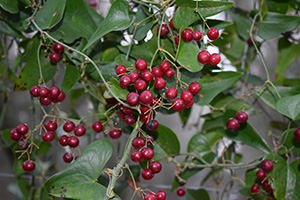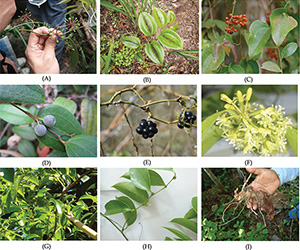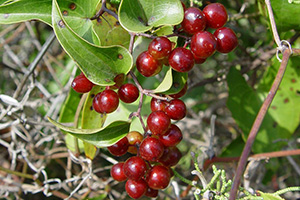It’s kind of amazing to me how few of the edible plants out there we actually eat. Big Ag and Big Food have limited our diets to foods that grow well in monocultures and are hearty enough to survive shipping.
But while the supermarket shelves may only stock a few varieties of lettuce and leafy greens, Mother Nature provides us with a much broader selection if you know what you are looking for.
Smilax is a wild superfood growing all around that you probably have never heard of. From root to tip, you can eat every part of this plant. So, it is a great one to know about for when SHTF.
Related: Do You Recognize this Tree? [All Parts are Edible]
Let’s take a closer look at what smilax is, how to identify and use it, and dangerous look-alikes. Then you can add one more plant to your foraging list.
What Is This Wild Superfood?
Never heard of smilax before? Perhaps you know it by one of its other common names, green briars, catbrier, or carrion vine. While smilax may be thorny and a little stinky (as its common names imply), don’t let that deter you from learning more about this wild superfood.
 While often referred to as vine, smilax is actually a climbing shrub. You can find it growing wild in the Eastern and Southeastern US. While it likes moist woodlands, it is hearty enough to survive dry periods as well. And it can aggressively climb trees or create dense brier patches.
While often referred to as vine, smilax is actually a climbing shrub. You can find it growing wild in the Eastern and Southeastern US. While it likes moist woodlands, it is hearty enough to survive dry periods as well. And it can aggressively climb trees or create dense brier patches.
There are over three hundred different species found east of the Rockies, which can make identification seem intimidating. But don’t worry, once you get the hang of it, you’ll realize it’s rather easy.
Plant Identification
The sheer number of varieties can make the idea of identifying smilax seem overwhelming. However, the first thing to realize not all varieties will grow in your region. So rather than three hundred species, you can focus on the nine or ten that are native to your area.

The best place to learn to identify your local species is through a local horticulture society, Master Gardener program, or university extension program.
The University of Florida Extension, for example, has a publication identifying the nine most common smilax species of Florida.
But let’s look at some of the common identifying features.
Leaves
![The Wild Superfood You Didn’t Know About [All Parts Are Edible]](https://www.askaprepper.com/wp-content/uploads/2021/12/The-Wild-Superfood-You-Didnt-Know-About-All-Parts-Are-Edible-3.jpg) With so many species of smilax, the leaves come in all colors, shapes, and sizes. That being said, there are some similarities that you will find between all species.
With so many species of smilax, the leaves come in all colors, shapes, and sizes. That being said, there are some similarities that you will find between all species.
All species will have palmate leaves. The means the veins on the leaf all originate from the same central point.
Beyond that, they may be heart-shaped or lance-shaped, dark green, light green, or speckled. Smilax’s leaves can vary greatly.
Twining and thorny
![The Wild Superfood You Didn’t Know About [All Parts Are Edible]](https://www.askaprepper.com/wp-content/uploads/2021/12/The-Wild-Superfood-You-Didnt-Know-About-All-Parts-Are-Edible-4.jpg) Another feature of smilax is that it is both twining and thorny. As most plants do either one or the other, this feature can help you identify smilax.
Another feature of smilax is that it is both twining and thorny. As most plants do either one or the other, this feature can help you identify smilax.
At the ends of the plant, you will see the tendrils that smilax uses to climb. Trace these back to the vine.
If the stems have thorns, that you can be pretty confident you’ve found smilax. Look for the palmate leaves to be certain.
Lookalikes
![The Wild Superfood You Didn’t Know About [All Parts Are Edible]](https://www.askaprepper.com/wp-content/uploads/2021/12/The-Wild-Superfood-You-Didnt-Know-About-All-Parts-Are-Edible-5.jpg) Make sure you use caution when foraging for smilax. Most vines you encounter in the wild are poisonous, and some, like English Ivy, look very similar.
Make sure you use caution when foraging for smilax. Most vines you encounter in the wild are poisonous, and some, like English Ivy, look very similar.
English ivy features palmate leaves of varying shapes and sizes, just like smilax. It also has tendrils that climb.
The defining feature to look for is the thorny stem. Smilax has stems while ivy does not.
Related: 8 Edible Backyard Plants And Their Poisonous Lookalikes
Uses
![The Wild Superfood You Didn’t Know About [All Parts Are Edible]](https://www.askaprepper.com/wp-content/uploads/2021/12/The-Wild-Superfood-You-Didnt-Know-About-All-Parts-Are-Edible-6.jpg) Once you have positively identified smilax, then you can begin to decide what to do with it. As we mentioned, all the plant’s parts can be used either edible or medicinally.
Once you have positively identified smilax, then you can begin to decide what to do with it. As we mentioned, all the plant’s parts can be used either edible or medicinally.
Traditionally, the plant was used to treat syphilis, though I wouldn’t recommend it.
However, studies show that the smilax plant is antibacterial, antifungal, and antiinflammatory. It can be effective at treating psoriasis, arthritis, and liver problems. High in vitamins and minerals, smilax is a great addition to your diet.
Roots
![The Wild Superfood You Didn’t Know About [All Parts Are Edible]](https://www.askaprepper.com/wp-content/uploads/2021/12/The-Wild-Superfood-You-Didnt-Know-About-All-Parts-Are-Edible-7.jpg) Perhaps the best-known use of smilax comes from the roots. Sasparilla and root beer were traditionally flavored with smilax roots along with other roots. These drinks were originally sold as medicinal tonics. But that isn’t the only way to use the roots- they can be roasted or cooked like other roots and tubers.
Perhaps the best-known use of smilax comes from the roots. Sasparilla and root beer were traditionally flavored with smilax roots along with other roots. These drinks were originally sold as medicinal tonics. But that isn’t the only way to use the roots- they can be roasted or cooked like other roots and tubers.
In addition, they can also be dried and ground into flour. Historically, people also used smilax roots to thicken stews.
Related: 6 Backyard Plants You Can Turn Into Bread
Sasparilla Recipe
Traditionally sasparilla used Smilax regelii, often referred to as Jamaican sasparilla root and sassafras root. Saponins in smilax help give sasparilla its distinctive foaminess. Sassafras root was responsible for the distinctive flavor we associate with rootbeer.
However, a study showed that sassafras might cause cancer in rats when consumed in large quantities. At which point, the FDA required commercial rootbeer manufacturers to stop using it. (It should be noted that the amount of sassafras consumed by animals in the study was the equivalent of a human consuming 12 thirty-two ounce rootbeers a day!)
Birchbark was also a common ingredient that added a distinctive wintergreen flavor. Other roots and spices, like ginger, anise, licorice root, cinnamon and vanilla, were often added to traditional brews as well.
![The Wild Superfood You Didn’t Know About [All Parts Are Edible]](https://www.askaprepper.com/wp-content/uploads/2021/12/The-Wild-Superfood-You-Didnt-Know-About-All-Parts-Are-Edible-11.jpg) You can make a delicious sasparilla at home using this wild superfood root, sassafras, and a combination of other herbs and spices to your taste.
You can make a delicious sasparilla at home using this wild superfood root, sassafras, and a combination of other herbs and spices to your taste.
I keep a ginger bug going in my home for brewing sodas and ginger beer, but you can use kombucha or water kefir as well.
And if you don’t have any ferments going at home already, you can always try commercial yeast. I used to use ¼ tsp of bread yeast per two-liter bottle before I started my ginger bug.
Instructions
- 10 cups of water
- ¼ cup of smilax regelii root
- ¼ cup of sassafras root
- 1 tbsp ginger root
- 1-star anise pod
- 2 tsp of vanilla extract (or 1 vanilla bean)
- 2 tbsp of birchbark
- 1 cup of unrefined sugar
- ½ cup of ginger bug
1. Add water and your spices to a large pot and bring to a boil.
2. Turn down heat to medium-low and simmer for 20-30 minutes.
3. Remove from heat and stir in sugar.
4. Allow the mixture to cool.
5. Strain out the spices.
6. Add the mixture to either flip-top bottles or clean plastic bottles.
![The Wild Superfood You Didn’t Know About [All Parts Are Edible]](https://www.askaprepper.com/wp-content/uploads/2021/12/The-Wild-Superfood-You-Didnt-Know-About-All-Parts-Are-Edible-8.jpg)
7. Leave for 3 days to ferment and get bubbly. Cooler climates may require additional time. If you are using plastic bottles, you can check on your fermentation by squeezing them.
If they feel hard to squeeze (think of an unopened soda bottle), they are done.
Don’t leave them too long. The bubbles will build up pressure, and over fermented beverages can explode.
8. When the fermentation is complete, move to the refrigerator to chill. Wait a few days for the distinctive bubbliness of sasparilla to appear.
9. Open and enjoy.
You can add other spices and vary the quantities to find your ideal flavor. You can also substitute some or all of the sugar with molasses for a more traditional brew.
Leaves & Stems
![The Wild Superfood You Didn’t Know About [All Parts Are Edible]](https://www.askaprepper.com/wp-content/uploads/2021/12/The-Wild-Superfood-You-Didnt-Know-About-All-Parts-Are-Edible-9.jpg) You can eat the tender young leaves and stems of the smilax plant. It’s best if you harvest in the spring. When you find the shoots, always make sure you confirm the plant has both tendrils and thorns.
You can eat the tender young leaves and stems of the smilax plant. It’s best if you harvest in the spring. When you find the shoots, always make sure you confirm the plant has both tendrils and thorns.
Then you can go ahead and harvest the tender rather than woody parts.
You can eat the leaves and stems raw in small quantities, but they can cause digestive problems in large quantities. You can also cook them gently.
Related: 15 Common Wild Plants You Never Thought Were Edible
This can help improve the flavor, as well. Use them like you would use spinach or asparagus, depending on if you are eating more leaves or stems.
Berries
 This wild superfood produces berries in the fall. They are usually reddish and often appear to hang from the vine, like grapes.
This wild superfood produces berries in the fall. They are usually reddish and often appear to hang from the vine, like grapes.
While smilax berries are edible, they are small and often contain a large inedible seed. You would have to eat an awful lot of them to satisfy yourself.
And since they provide food to a whole host of woodland critters, I would save them for a true survival situation.
If you do plan to eat smilax berries, make sure you engage in proper identification. Many red berries that appear in the fall are poisonous.
The Wild Superfood
Smilax is one more plant to add to your foraging list. You can eat this versatile plant from root to tip. High in vitamins and minerals, as well as having medicinal properties, smilax is a useful plant you won’t find in the supermarket aisle.
But as you go out for your walk in the woods this spring, keep an eye out for smilax growing by woodland steams. If you see the vines with thorns and tendrils, cut some tender shoots to try for dinner.
You may also like:
 10 Survival DIY Projects You Can Start on Your Property Right Now
10 Survival DIY Projects You Can Start on Your Property Right Now
This Hidden Survival Garden Will Keep You Well Fed When SHTF (Video)
Strange and Effective Way to Store Bacon for 15+ Years
Computer Tech Shows The DHS Just How Easy It Is To Breach The Security Of The Power Grid

![The Wild Superfood You Didn’t Know About [All Parts Are Edible]](https://www.askaprepper.com/wp-content/uploads/2021/12/The-Wild-Superfood-You-Didnt-Know-About-All-Parts-Are-Edible-0.jpg)













What an interesting article! It is way too late to make Sasparilla for Christmas, but good to know how it is made and how to make it! Bubbly too so it would be quite festive! Cheers!
As there are some toxic look alike species can I suggest you take a moment to visit eat the weeds and check out Birch trees.
The main thing to remember is that Smilax always has thorns and tendrils, the slender tendrils grow out from the stems and twist and twine around anything they can reach, the thorns also grow out from the stems and are viciously sharp and recurved. Snailseed for example is common and toxic, has tendrils but no thorns. In fact the only other thorny vines I can think of, at least in Texas are in the rose family, dewberry, rasberry, blackberry, wild roses, all edible.
The article comments that Big Ag and Big Food limit what plants we eat, truth be told most wild survival plants aren’t what you would call tasty. Steak, baked potato, and hot buttered yeast rolls will always outsell squirrel, baked Smilax tuber, and acorn flour muffins.
Judge you’d be amazed how many folks show up in our ER with troubles from eating “Wild Foods” clutching a good Wild Food Manual.
It’s not always the plant at hand. Often it’s the not so nice plant nearby. Sometimes it’s the sprays folks use to “Control” such wild weeds. Sometimes it’s the Red Ant (no offence to our poster so named) colony OFFENDED by their harvesting efforts.
I have a few “Wild Foods” I am trusting in my area BUT that’s because I PLANTED THEM inside tractor tires as food patches. I know they are not sprayed; I have positive ID of them. They are often great for early food when Spring AKA the STARVING Season comes in.
Spring was known as the Starving Season before 365 days a year Bannas became cheap and available in a grocery store BECAUSE that was when the food stored in jars and root cellars was running LOW, The Wildlife was poor eating as they too were nearly starved suffering through winter and folks NEEDED something healthy as a Tonic.
Gardeners can tell you just how far between planting and nurturing that seed before it becomes something to fill your belly. Potatoes 80 day before baby potatoes are ready, main crop closer to 110 days. Some varieties are quicker but not by much. Bok Choy Chinese cabbage is 40 days for baby more for full sized.
Thus, our European forefathers BROUGHT IN Dandelions as a Spring Herb and Tonic, available weeks before anything else was edible.
Eat the weeds is a good site for wild crafting.
Time and energy (sometimes called money) is a limited resource. People need somewhere in the 2K range of calories for “Modern Life”. More active physical lifestyle adds more calories to that need. An acre of most “Wild Foods” is but a few thousand calories at best and easily Wiped OUT. ONE Medium Potato is 164 belly filling calories. Healthy amount of Vit C, Protein and more also.
Calories per acre for various foods
Food Million calories per acre
Wheat 6.4
Corn 12.3
Potatoes 17.8
And I can use those potatoes to plant MORE. With modern techniques (LOL most used before Petroleum fertilizer became common) I can grow in many places two or three crops in that acre.
Ever WONDER why Wheat is in nearly every processed food in the world? Now you know, Millions of calories per acre.
I vote for Potatoes as a Superfood
Although potatoes in one form or another are just about everyone’s favorite side dish and relatively easy to grow, I would not classify potatoes as a true super food. If not handled properly, potatoes green and that means that they have a high concentration of solanine, a poisonous alkaloid, which is why eating green potatoes can have effects ranging from mild discomfort to respiratory failure, and eating raw potatoes is never a good idea.
City Chick if you handle any food improperly they can become unsafe. Wheat berries grow potentially lethal molds and so forth.
Good news Green Potatoes although not good to eat are still good for Planting for next year’s crop. In fact that Greening is nature’s way of preventing animals from eating the year’s crop of Potatoes.
Remember that the potato didn’t grow for humans to eat but to grow more Potatoes. We get to enjoy eating them.
Most wildcrafted foods require cooking.
In my opinion a “Super Food ” should feed me well, be tasty and give me a good amount of nutrition. Being easy to grow is a Bonus.
This was a very well written article.
Merry Christmas to all of you who have contributed thought provoking comments and added to my education. May you all be blessed this Christmas.
A Very Merry Christmas! May the Christmas Story shine God’s Glory in your heart and home!
A very Merry Christmas to All.
Michael,
Passed along your msg to Tmac through the channels.
Peace
MadFab
Thank you MadFab, a healthy and peaceful Christmas+ to you and yours.
Anyone heard from ClergyLady lately?
Sure hope she is doing OK.
First Christmas since DH passed.
Sending prayers and blessings her way.
Peace
MadFab
MadFab, The last comment from ClergyLady, that I have seen on this site, was 2 weeks ago. It was regarding the article on tracking.